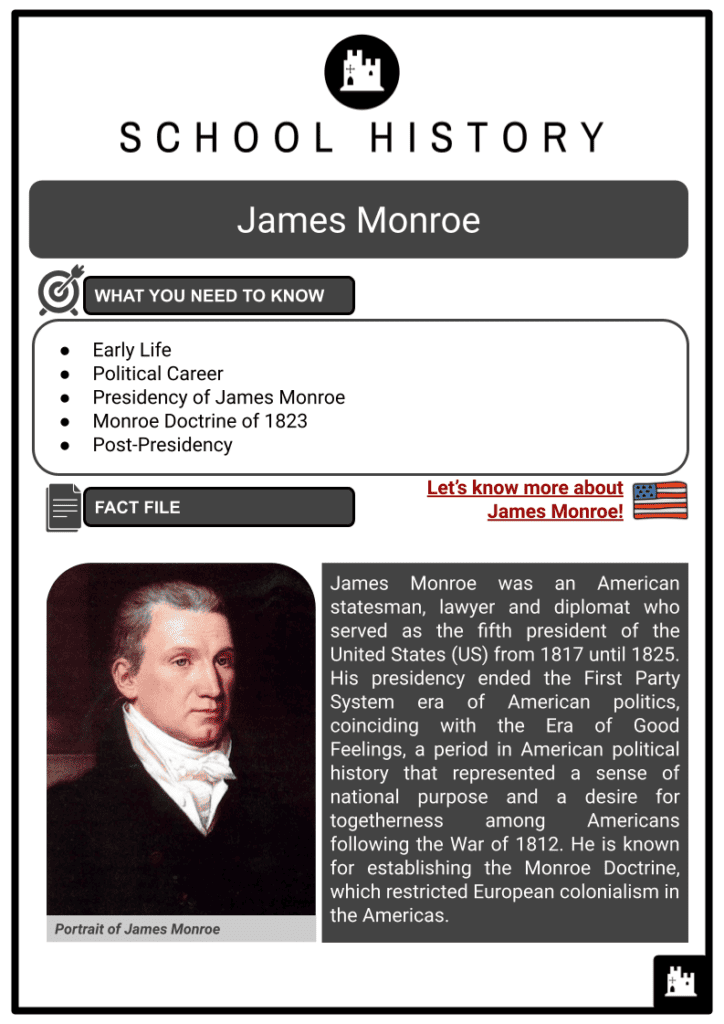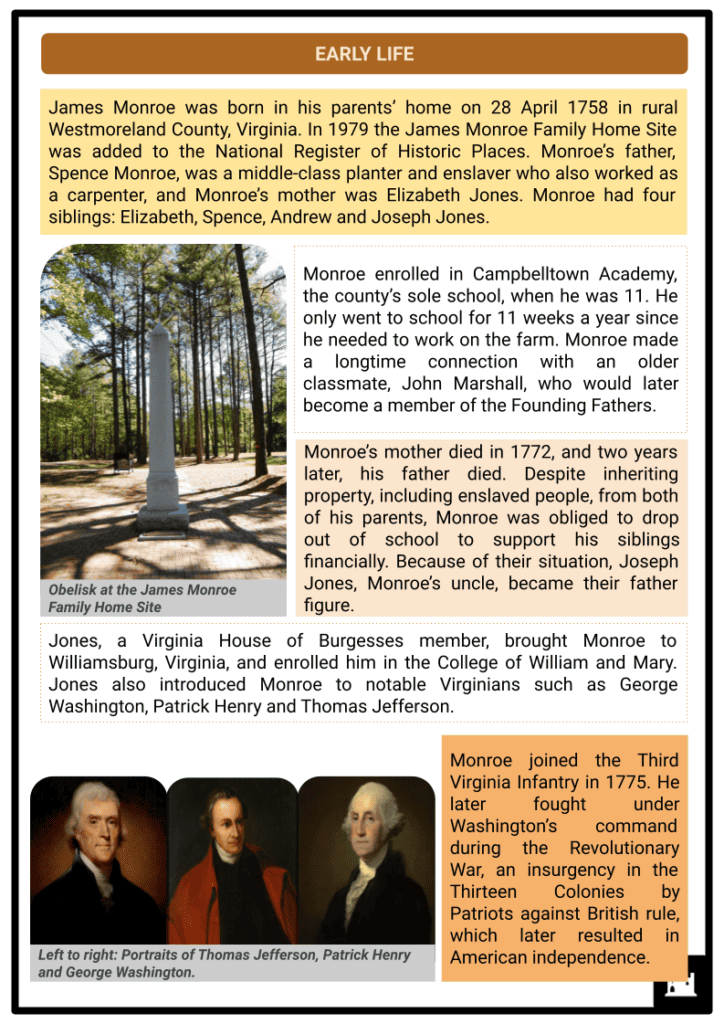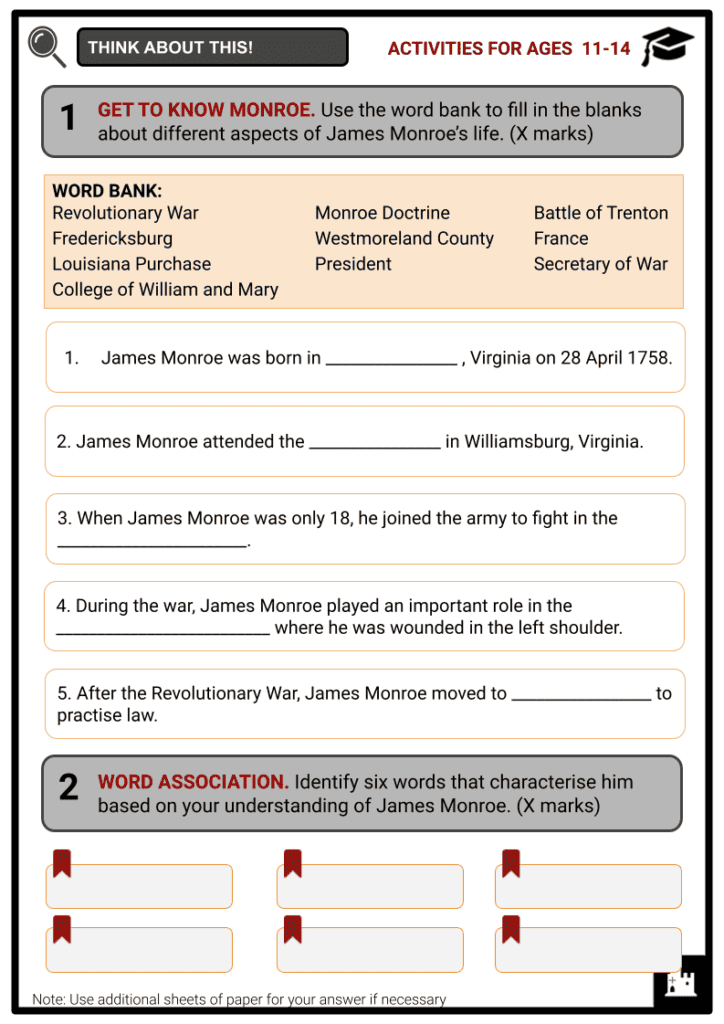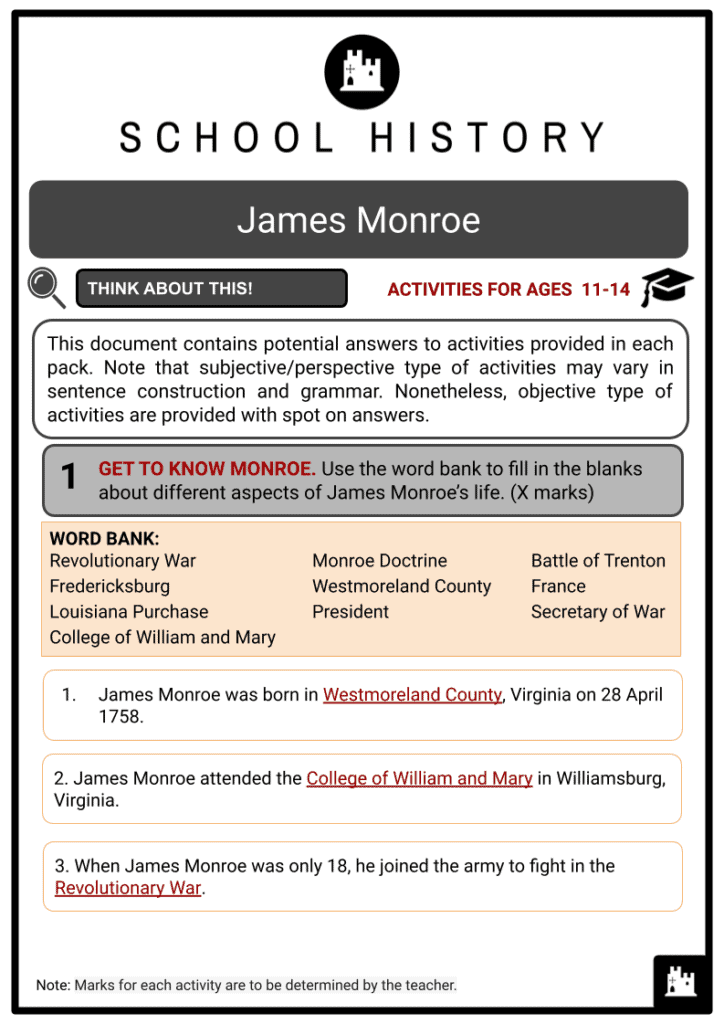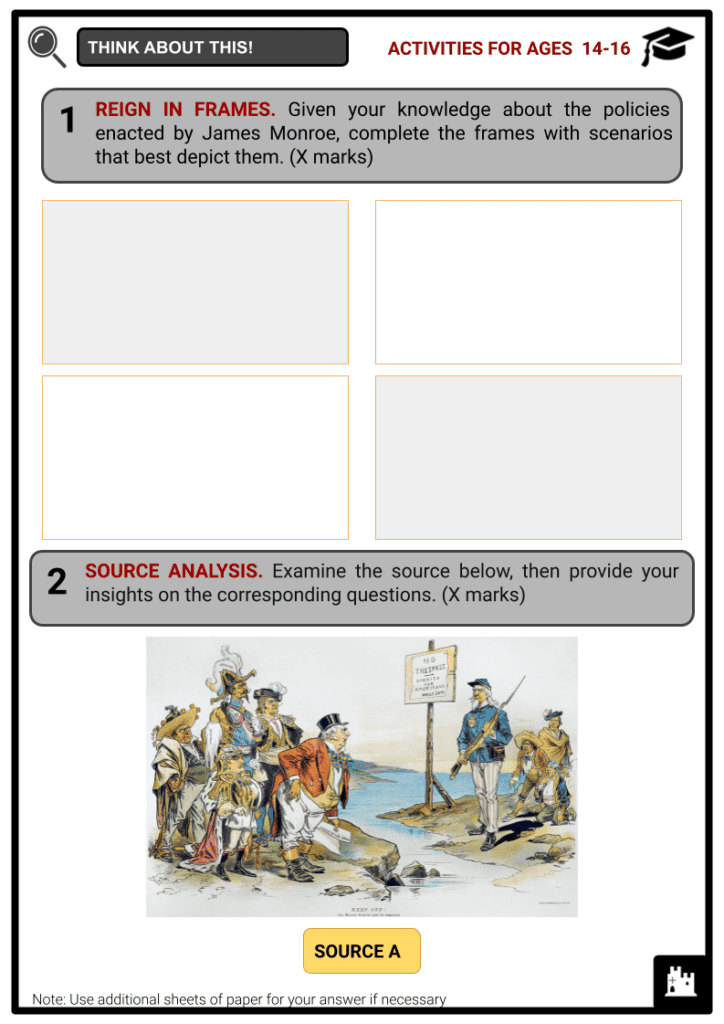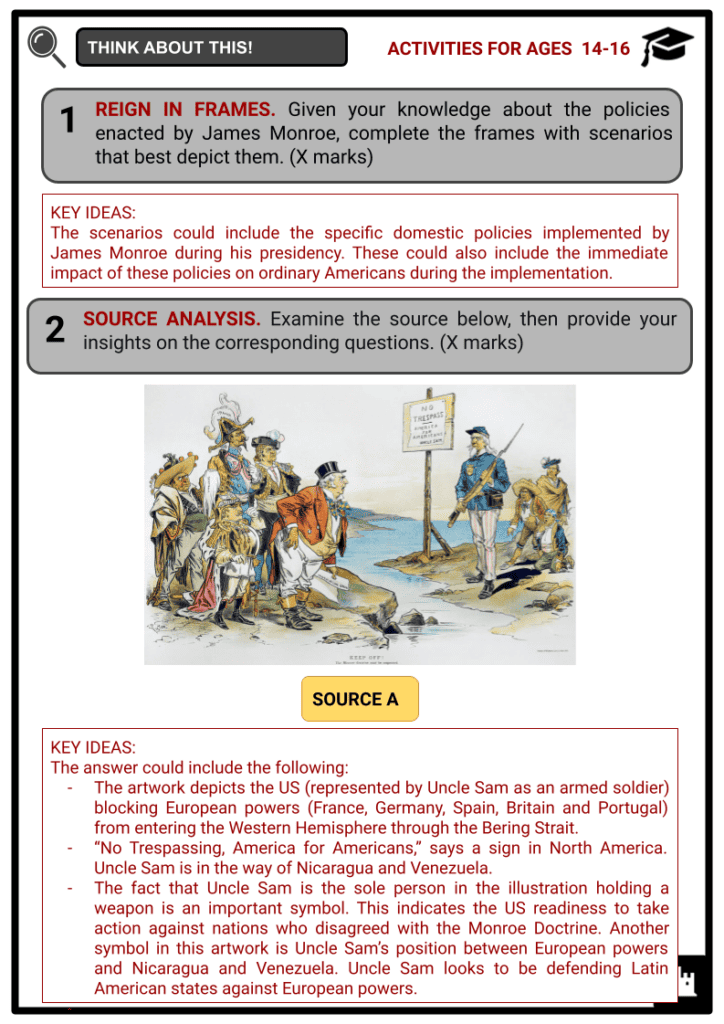James Monroe Worksheets
Do you want to save dozens of hours in time? Get your evenings and weekends back? Be able to teach about James Monroe to your students?
Our worksheet bundle includes a fact file and printable worksheets and student activities. Perfect for both the classroom and homeschooling!
Summary
- Early Life
- Political Career
- Presidency of James Monroe
- Monroe Doctrine of 1823
- Post-Presidency
Key Facts And Information
Let’s know more about James Monroe!
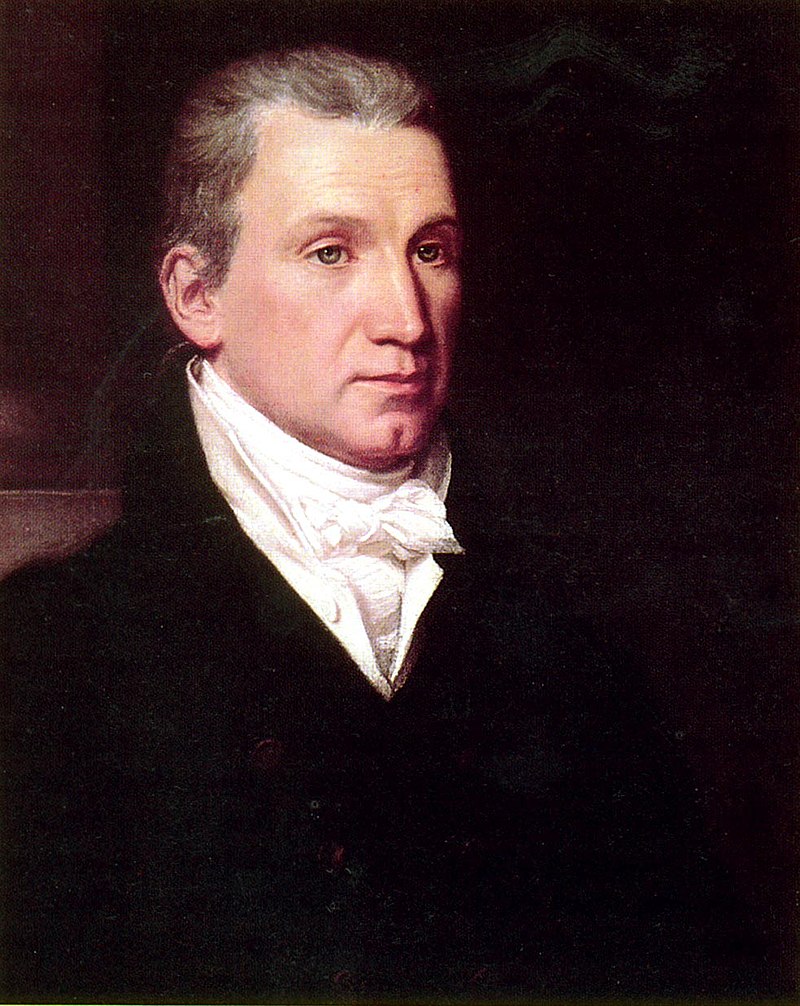
James Monroe was an American statesman, lawyer and diplomat who served as the fifth president of the United States (US) from 1817 until 1825. His presidency ended the First Party System era of American politics, coinciding with the Era of Good Feelings, a period in American political history that represented a sense of national purpose and a desire for togetherness among Americans following the War of 1812. He is known for establishing the Monroe Doctrine, which restricted European colonialism in the Americas.
EARLY LIFE
- James Monroe was born in his parents’ home on 28 April 1758 in rural Westmoreland County, Virginia. In 1979 the James Monroe Family Home Site was added to the National Register of Historic Places. Monroe’s father, Spence Monroe, was a middle-class planter and enslaver who also worked as a carpenter, and Monroe’s mother was Elizabeth Jones. Monroe had four siblings: Elizabeth, Spence, Andrew and Joseph Jones.
- Monroe enrolled in Campbelltown Academy, the county’s sole school, when he was 11. He only went to school for 11 weeks a year since he needed to work on the farm. Monroe made a longtime connection with an older classmate, John Marshall, who would later become a member of the Founding Fathers.
- Monroe’s mother died in 1772, and two years later, his father died. Despite inheriting property, including enslaved people, from both of his parents, Monroe was obliged to drop out of school to support his siblings financially. Because of their situation, Joseph Jones, Monroe’s uncle, became their father figure.
- Jones, a Virginia House of Burgesses member, brought Monroe to Williamsburg, Virginia, and enrolled him in the College of William and Mary. Jones also introduced Monroe to notable Virginians such as George Washington, Patrick Henry and Thomas Jefferson.
- Monroe joined the Third Virginia Infantry in 1775. He later fought under Washington’s command during the Revolutionary War, an insurgency in the Thirteen Colonies by Patriots against British rule, which later resulted in American independence.
Life during the Revolutionary War
- At the Battle of Trenton in late 1776, Monroe took part in a surprise attack on a Hessian encampment. Despite the success of the attack, Monroe suffered a severed artery during the battle and nearly died. Following the battle, Washington praised Monroe and Captain William Washington for their courage and promoted Monroe to captain. Monroe returned to Virginia once his wounds healed to form his own company of soldiers.
- Monroe, lacking the means to entice recruits to join his company, requested that Jones restore him to the front lines. Monroe was assigned to General William Alexander. During this time, he became close to the Marquis de Lafayette, a French volunteer who pushed him to see the conflict as part of a larger struggle against religious and political tyranny.
- With the British concentrating their operations in the southern colonies, Virginians relocated the capital to the better-fortified city of Richmond, and Monroe accompanied Jefferson to the new capital. As governor of Virginia, Jefferson oversaw the militia and promoted Monroe to colonel. Monroe set up a messenger system to communicate with the Continental Army and other state militias.
- Monroe returned to his house in King George County, unable to organise an army due to a lack of willing volunteers, and was therefore not present for the British raid on Richmond. Following the war, he returned to the College of William and Mary to study law at Jefferson’s urging. After being admitted to the Virginia bar, Monroe worked in Fredericksburg.
Marriage Life
- While serving in the Continental Congress, Monroe met Elizabeth Kortright and, later on, married her on 16 February 1786. Kortright was the daughter of rich trader and former British officer Laurence Kortright and Hannah Aspinwall Kortright. The couple had three children: Eliza Monroe, James Spence Monroe and Maria Hester Monroe.
POLITICAL CAREER
- Monroe was elected to the Virginia House of Delegates in 1782. He was also elected to the Congress of the Confederation in November 1783, and he remained at Annapolis until Congress convened in Trenton, New Jersey. He had been in that position for three years until the rule of rotation forced him to step down.
- The government was gathering in the interim capital of New York City at the time. Monroe travelled across Western New York and Pennsylvania in 1784 to evaluate the circumstances in the Northwest. The tour persuaded him that the US needed to pressure Britain to relinquish its regional stations and reclaim control of the Northwest.
- While in Congress, Monroe became a proponent of Western development and was instrumental in creating and approving the Northwest Ordinance. The ordinance established the Northwest Territory, providing federal control of the territories west of Pennsylvania and north of the Ohio River.
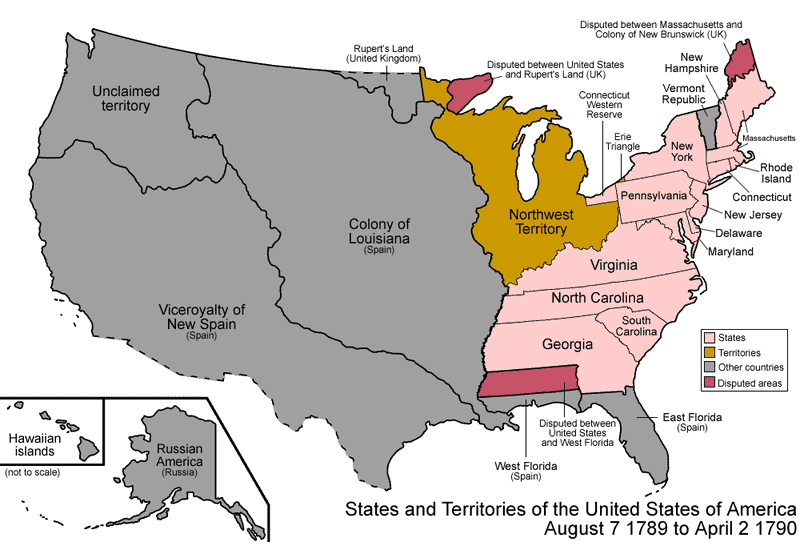
Map of the US in 1789, when the Northwest Territory was organised - Monroe resigned from Congress in 1786 to pursue a legal career and became a state attorney. Monroe was re-elected to the Virginia House of Delegates in 1787. The battle over ratifying the proposed Constitution in Virginia was more than a confrontation between federalists and anti-federalists. Virginians maintained a wide range of views on the merits of the proposed shift in national government.
- Monroe and Edmund Pendleton led this group of federalists who were asserting for amendments. The group decried the lack of a bill of rights and was concerned about ceding taxation powers to the central government. Virginia was the tenth state to ratify the Constitution, and all thirteen states subsequently ratified the Constitution.
Monroe as US Senator
- During Washington’s presidency, American politics grew increasingly polarised between supporters of Secretary of State Thomas Jefferson and the Federalists, led by Secretary of the Treasury Alexander Hamilton. Monroe staunchly opposed Hamilton’s strong central government and powerful presidency.
- The Democratic-Republican Party sprang up around Jefferson and Madison, and Monroe became one of the young party’s Senate leaders. He also helped organise the opposition to John Adams in the 1792 election, but Adams defeated George Clinton to keep his post as vice president.
- Also, during this period, James Reynolds and Jacob Clingman were imprisoned in November 1792 for counterfeiting and speculating on Revolutionary War veterans’ unpaid back wages. Monroe, Frederick Muhlenberg and Abraham Venable investigated the claims. They discovered Hamilton making payments to Reynolds and suspected Hamilton of being engaged in the charges.
- When they questioned Hamilton about it, he denied any involvement in the charges but admitted to making money to Reynolds and explained that he’d had an affair with Maria, Reynolds’ wife. Clingman informed Maria of the allegation that she had an affair with Hamilton, which she disputed, stating that the pieces of evidence had been manufactured to assist in covering up the corruption.
- Unfortunately, the secretary in charge of the pieces of evidence copied them and provided them to scandal reporter James Callender. Five years later, Callender made accusations against Hamilton based on the pieces of evidence just after Monroe was recalled from France.
- Hamilton and his wife suspected Monroe of vengeance for the recall and approached him via letter. Hamilton was unhappy with Monroe’s explanation, and by the end of a letter exchange, the two were threatening confrontation again. Aaron Burr served as a mediator between the two sides and eventually helped settle the dispute.
Influence on American Diplomacy
- The French Revolutionary Wars dominated US foreign policy as the 1790s continued, with British and French attacks endangering US trade with Europe. Like most other Jeffersonians, Monroe backed the French Revolution, although Hamilton’s adherents were more sympathetic to Britain.
- To avoid war with both countries, Washington appointed Monroe as his Ambassador to France in 1794. Simultaneously, he appointed the anglophile Federalist John Jay as his envoy to the United Kingdom (UK). Jay’s Treaty thwarted Monroe’s efforts to maintain friendly relations with the French government, and he was recalled in 1796. The Jay Treaty was a 1794 treaty between the US and the UK that averted war, resolved issues left over from the Treaty of Paris of 1783 (which ended the American Revolutionary War), and facilitated ten years of peaceful trade between the two countries during the French Revolutionary Wars, which began in 1792.
- Monroe returned to France in 1803 after assisting Robert Livingston with the Louisiana Purchase discussions. Monroe was also Minister to Britain from 1803 to 1807, hampered by disagreements over the US’ neutrality rights. Monroe travelled to Spain in 1805, intending to gain acknowledgement for the US’ ownership of West Florida. They claimed the land as part of the Louisiana Purchase, but Monroe could not obtain the Spanish government’s approval.
- Monroe collaborated with Special Commissioner William Pinkney in 1806 to prevent British impressment of American seamen and to gain neutral commercial rights. The planned Monroe-Pinkney Treaty, however, failed to resolve concerns, and President Jefferson declined to send it to the Senate.
- In 1811, while serving as Secretary of State, Monroe grew convinced that declaring war on Great Britain was the greatest option for changing offensive British policy. Monroe and Madison urged Congress to approve a declaration of war on 17 June 1812. During the War of 1812, Monroe expertly supervised the growth of the US military occupation of Florida and acted as acting Secretary of War.
- Monroe, now in command of the war effort, directed General Andrew Jackson to defend New Orleans against a possible British attack, and he requested that the governors of neighbouring states send their militias to aid Jackson. He also urged Congress to create a 100,000-man army, improve military pay, and build a new national bank to ensure adequate money for the war effort.
- With the Treaty of Ghent signing, the war ended, and Monroe assumed office as Secretary of War. The Treaty returned to the pre-war status quo, with several remaining disputes between the US and Britain. However, Americans welcomed the war’s end as a tremendous victory, partly thanks to news of the Treaty reaching the country shortly after Jackson’s victory in the Battle of New Orleans.
- The British discontinued the practice of impressment with the end of the Napoleonic Wars in 1815. Following the war, Congress authorised the establishment of a national bank, the Second Bank of the United States (BUS).
1816 Election
- Monroe planned to run for President in the 1816 election, establishing himself as Madison’s heir apparent throughout the war. Many in the party backed Monroe, but his candidacy was questioned in the Democratic-Republican congressional nominating caucus in 1816. Secretary of the Treasury William H Crawford supported several Southern and Western Congressmen, while Governor Daniel D Tompkins supported some New York Congressmen.
- The Federalists nominated Rufus King for President, but the party gave no opposition following the end of a popular war they had opposed. Monroe won every state except Massachusetts, Connecticut and Delaware, receiving 183,217 electoral votes. He was the last President to be a Founding Father, having previously served as a commander in the Continental Army and as a delegate in the Continental Congress.
PRESIDENCY OF JAMES MONROE
- James Monroe’s administration began on 4 March 1817, when he was inaugurated as President of the US, and concluded on 4 March 1825. Monroe became the fifth President of the US after defeating Federalist Rufus King in the 1816 presidential election. The Federalists did not submit a presidential candidate in this election, and Monroe ran unchallenged in the 1820 presidential election.
- Monroe picked a regionally diverse cabinet to lead the executive branch. Recognising Northern unhappiness with the continuation of the Virginia dynasty, Monroe appointed Massachusetts’s John Quincy Adams to the prominent position of Secretary of State, making Adams the early choice to follow Monroe as President.
- Adams, an experienced diplomat, had abandoned the Federalist Party in 1807 in support of Jefferson’s foreign policy, and Monroe believed that his appointment would persuade additional Federalists to resign.
Monroe Cabinet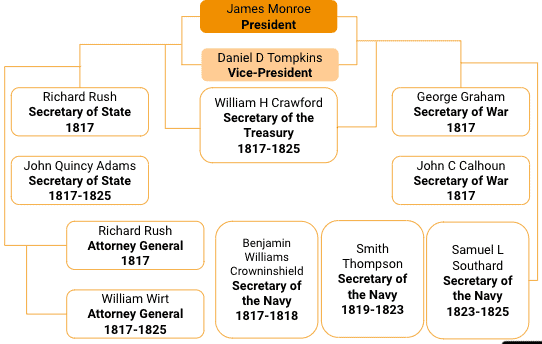
Domestic Affairs: Democratic-Republican Party dominance
- Like his four predecessors, Monroe believed that the establishment of political parties was detrimental to the US, and he made eliminating political parties a major priority of his presidency.
- He aimed to build the Democratic-Republican Party by avoiding contentious ideas and allowing ex-Federalists back into the fold, ultimately dissolving the Federalists. Monroe went on two lengthy national tours to gain public trust. His 1817 visit to Boston was heralded as the start of an Era of Good Feelings.
Domestic Affairs: Panic of 1819
- Monroe faced the Panic of 1819, the first serious depression in American history, two years into his presidency. The panic was sparked by falling imports and exports and sinking agricultural prices as global markets returned to peacetime production and commerce following the War of 1812 and the Napoleonic Wars.
- The BUS failed to limit inflation until late 1818 when the BUS directors took long-overdue moves to limit credit. Branches were instructed to take only their bills, to provide all state bank notes for rapid payment, and to renew no personal notes or mortgages. These contractionary fiscal policies backfired, undermining public trust in banks and contributing to the outbreak of panic. Monroe had minimal influence on economic policy: in the early 19th century, such power was mostly held by the states and the BUS.
- Monroe refused to summon a special session of Congress to address the economy as the panic spread. When Congress reconvened in December 1819, Monroe requested a tariff increase but refused to offer particular rates.
- Congress would not raise tariff rates until the Tariff of 1824 was passed. The panic caused widespread unemployment, increased bankruptcies and foreclosures, and fuelled public anger at banks and business companies. The Supreme Court barred states from taxing BUS branches, a major setback for states’ rights activists.
Domestic Affairs: Missouri Compromise
- The Missouri Compromise was a piece of United States federal legislation that sought to reconcile the goals of northern states to prevent the spread of slavery in the country with those of southern states to extend it.
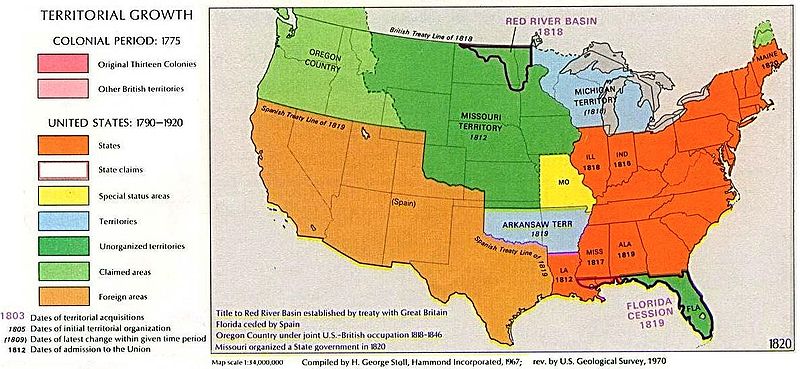
The US abolished slavery in the unorganised region of the Great Plains (upper dark green) in 1819, but permitted it in Missouri (yellow) and the Arkansas region (lower blue area). - It admitted Missouri as a slave state and Maine as a free state and proclaimed slavery illegal in the remaining Louisiana Purchase areas north of the 36°30′ line. The Act was passed by the 16th US Congress on 3 March 1820 and signed by Monroe on 6 March 1820.
- Monroe, an enslaver himself, promised to veto any bill that limited slavery in Missouri. He also backed Senator James Barbour and other Southern Congressmen’s efforts to gain Missouri’s admittance as a slave state by threatening to withhold statehood from Maine, a part of Massachusetts.
MONROE DOCTRINE OF 1823
- James Monroe explained the US’ attitude towards the new political order emerging in the rest of the Americas and Europe’s role in the Western Hemisphere in his address to Congress on 2 December 1823. The Monroe Doctrine was little noted by the Great Powers of Europe but eventually became a long-standing foundation of US foreign policy.
- Monroe and his Secretary of State, Adams, built on a foundation of American diplomatic ideals established in Washington’s Farewell Address and Madison’s declared rationale for launching the War of 1812.
- The Monroe administration warned the imperial European countries not to meddle in the affairs of newly independent Latin American governments or possible US possessions.
Three main concepts of the Monroe Doctrine
-
- separate spheres of influence for the Americas and Europe
- non-colonisation
- non-intervention
- The Monroe administration warned the imperial European countries not to meddle in the affairs of newly independent Latin American governments or possible US possessions.
- While most in the US opposed European colonies in the Americas, they also wanted the US to expand its influence and economic relations throughout the region to the south. The greatest impediment to economic expansion was European mercantilism.
- Americans, in particular, feared that Spain and France would reimpose colonialism on the Latin American peoples who had recently ousted European control. Russian signs of expanding its presence southward from Alaska towards the Oregon Territory were particularly concerning.
- For their part, the British had a great stake in guaranteeing the demise of Spanish colonialism, with all the trade limitations imposed by mercantilism.
- In 1823, British Foreign Minister George Canning proposed to Americans that the two countries sign a joint declaration to dissuade any other power from meddling in Central and South America.
- Monroe’s declaration, paired with beliefs of Manifest Destiny, gave precedent and support for US expansion on the American continent by the mid-1800s. The US economic and military power enabled it to impose the Monroe Doctrine in the late 1800s.
- The doctrine’s most significant extension came with Theodore Roosevelt’s Corollary, which inverted the doctrine’s original meaning and came to legitimise unilateral US intervention in Latin America.
POST-PRESIDENCY
- When his presidency ended on 4 March 1825, Monroe lived at Monroe Hill, which is now part of the campus of the University of Virginia. He remained virtually on the university’s Board of Visitors under Jefferson and the second rector, James Madison, both previous presidents, until his death.
- Monroe was elected as a delegate to the 1829-1830 Virginia Constitutional Convention. He was one of four delegates elected from his home district of Loudoun and Fairfax County’s senatorial district.
- He was voted presiding officer by the convention in October 1829 until his failing health forced him to resign on 8 December. At that point, Philip P Barbour of Orange County was elected.
- Monroe’s health began to deteriorate gradually towards the end of the 1820s. Monroe died on 4 July 1831, at the age of 73, of heart failure and tuberculosis, becoming the third president to have died on Independence Day.
- His death occurred 55 years after the proclamation of the United States Declaration of Independence and five years after the deaths of John Adams and Thomas Jefferson. Monroe was initially interred in New York in the vault of the Gouverneur family in the New York City Marble Cemetery.
- Monroe’s body was re-interred at the President’s Circle in Hollywood Cemetery in Richmond, Virginia, in 1858. The James Monroe Tomb is a United States National Historic Landmark.
Frequently Asked Questions
- Who was James Monroe?
James Monroe was the fifth President of the United States, serving from 1817 to 1825. He was also a Founding Father, diplomat, and Secretary of State and War.
- What is James Monroe best known for?
Monroe is best known for the Monroe Doctrine, a foreign policy that warned European powers against interfering in the affairs of the newly independent nations in the Americas.
- What was the Monroe Doctrine?
The Monroe Doctrine was a U.S. policy introduced by President James Monroe in 1823. It declared that the Western Hemisphere was closed to further European colonisation and that any attempt by European nations to interfere in the Americas would threaten the peace and safety of the United States.

